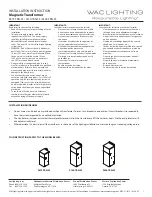
2) Board Separation
Remove the two screws that secure the control/loader board to the rear bracket. The rear
bracket stays connected to the RF board. Remove the two screws that secure the RF board
to the front bracket. The front bracket stays connected to the control/loader board. These
four screws are removed with a TORX T-9 driver. The two boards are held together by their
interconnecting header/socket. Gently pry the two boards apart at the header/socket. The
RF board is then rotated and tilted so to allow the right angle BNC connector to pass through
the hole in the front bracket.
3) Re-assembly is the reverse of assembly with the rear screws installed before the side
screws.
8
HARDWARE OPTIONS
The DTX is setup at the factory in a configuration that should be acceptable for most users. The
most common changes required are effected through the programmer without removing the cover
from the unit. There are, however, a number of component jumper changes which can be made
which may result in more satisfactory integration in a data system. These changes require the
soldering and unsoldering of SMD components and should be undertaken only by qualified
service personnel. Refer to the PCB component locator and schematic diagrams as needed.
8.1
CONTROL/LOADER BOARD OPTIONS
8.1.1
AUX OUT COUPLING
The AUX OUT output is normally AC coupled through C399. If DC coupling is desired, an 0805
size SMD zero ohm jumper resistor (RITRON P/N 47100000) must be soldered in the location of
MR384. (In lieu of a zero ohm jumper, a small piece of wire may be carefully soldered between
the pads.) The AUX OUT DC level then becomes nominally 1.67 volts.
8.1.2
AUX IN COUPLING
The AUX IN input is normally AC coupled through C343. DC coupling is possible, however, the
carrier frequency of the unit would then become directly affected by the DC voltage present. If
DC coupling is desired, an 0805 size SMD zero ohm jumper resistor (RITRON P/N 47100000)
must be soldered in the MR369 location
.
The DC voltage should be 2.5 volts nominal and very
well regulated.
Note: The FCC Type Acceptance obtained by RITRON is invalid once this
modification is made. The user is responsible for obtaining type acceptance in a
configuration which includes the device which is connected to the AUX IN input.
8.2
RF BOARD OPTIONS
8.2.1
DISCRIMINATOR POLARITY
The polarity of the discriminator output at pin 14 of J102 is configured at the factory such that an
increase in RF frequency causes an increase in DC voltage. This is considered “normal” mode.
An inverted mode is available where an increase in frequency causes a decrease in voltage. This
is effected by removing R130 and placing it in the open pad pair denoted as MR125.

































